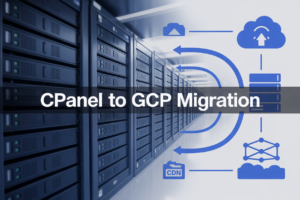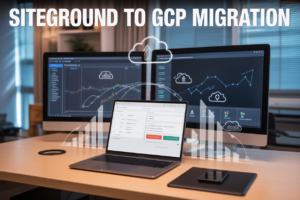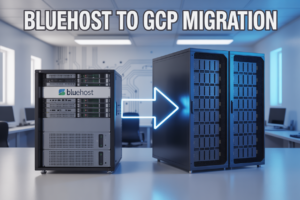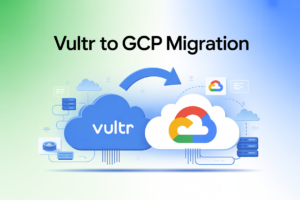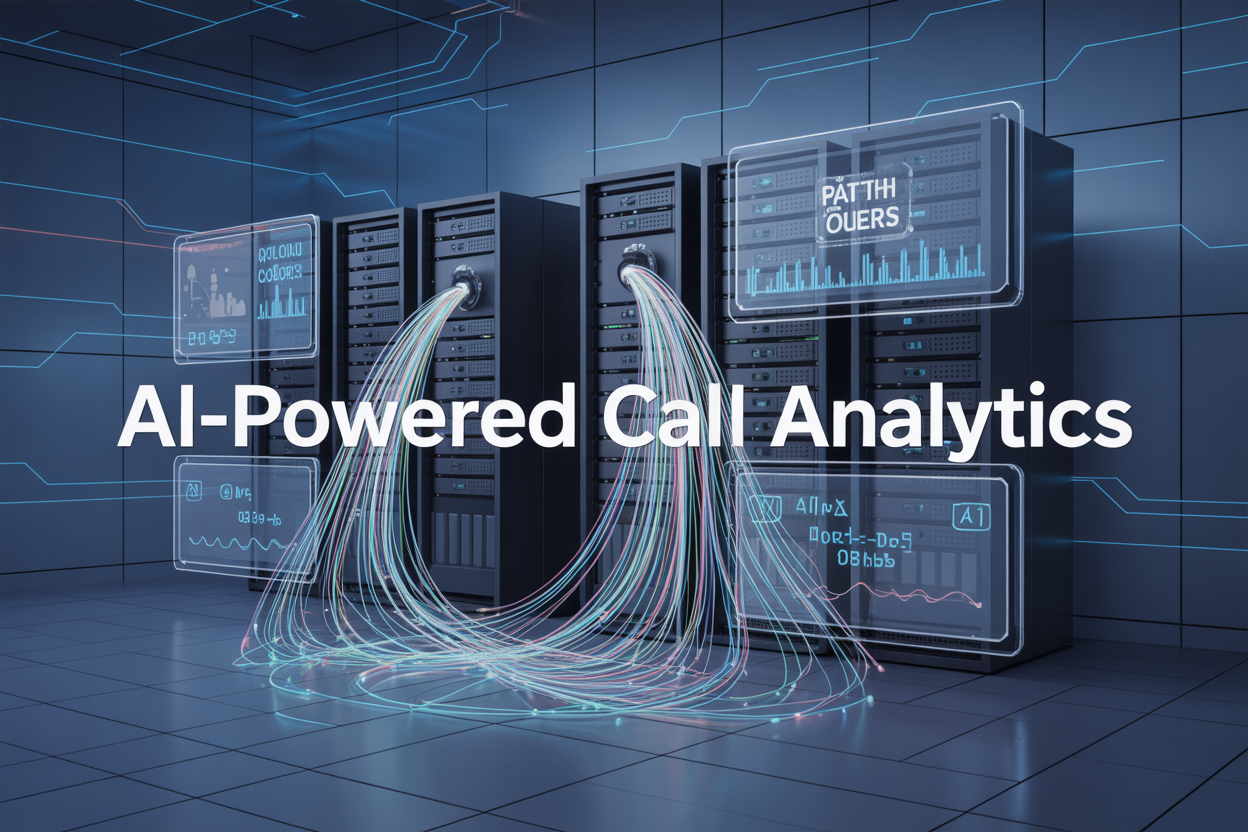
Call centers generate massive amounts of data every day, but turning millions of conversations into actionable insights requires serious technical firepower. AI-powered analytics combined with smart cloud architecture makes it possible to process, analyze, and extract value from this data at scale.
This guide is for IT architects, call center managers, and data engineers who need to build or understand robust call center analytics systems. You’ll learn how cloud-based call analytics platforms handle the complexity of processing thousands of simultaneous calls while delivering real-time insights.
We’ll break down the essential components of a cloud architecture that can handle millions of calls, explore how to design efficient data pipelines that keep costs manageable, and show you how AI call processing integrates with your existing contact center analytics platform. You’ll also discover the security considerations that matter most when building a voice analytics cloud solution.
Understanding the Scale Challenge of Call Center Analytics

Processing millions of voice recordings efficiently
Modern call centers generate enormous volumes of audio data that traditional systems struggle to handle. Contact center analytics platforms must process thousands of simultaneous conversations while extracting meaningful insights from each interaction. AI-powered analytics transforms this challenge by automating transcription, sentiment analysis, and compliance monitoring across millions of calls. Cloud-based call analytics solutions distribute processing loads across multiple servers, enabling parallel processing of vast audio datasets. The key lies in breaking down large audio files into manageable chunks that can be processed simultaneously, dramatically reducing analysis time from hours to minutes.
Real-time data streaming requirements
Live call analysis demands immediate processing capabilities that push system limits. Voice analytics cloud infrastructure must handle continuous data streams while delivering insights within seconds of conversation completion. Real-time processing requires robust streaming architectures that can manage peak call volumes without dropping connections or losing data integrity. Call center AI systems need to balance speed with accuracy, processing audio streams as they arrive while maintaining quality standards. The streaming pipeline must accommodate varying call durations, multiple languages, and different audio quality levels without compromising performance.
Storage demands for large-scale audio files
Audio files consume massive storage space, with enterprise call centers accumulating terabytes of data monthly. A single hour of high-quality audio requires approximately 100MB of storage, making efficient compression and archiving critical. Cloud architecture enables scalable storage solutions that automatically adjust to growing data volumes while maintaining quick access to recent recordings. AI analytics architecture must balance storage costs with retrieval speed, implementing tiered storage strategies that move older files to cheaper, slower storage mediums. Smart data lifecycle management policies automatically delete unnecessary recordings while preserving compliance-required conversations.
Performance bottlenecks in traditional systems
Legacy call center systems create significant processing delays when analyzing large conversation volumes. Traditional on-premises infrastructure lacks the scalability to handle sudden spikes in call volume or complex AI processing requirements. Single-server architectures become overwhelmed during peak periods, creating backlogs that delay critical insights. Call center data pipeline limitations force sequential processing of audio files, multiplying analysis time exponentially as volume increases. Network bandwidth constraints between storage and processing components further compound delays, making real-time analytics virtually impossible with conventional setups.
Core Components of Cloud-Based AI Analytics Architecture

Auto-scaling speech recognition services
Cloud-based speech recognition services automatically adjust processing capacity based on incoming call volumes, ensuring consistent performance during peak times while optimizing costs during slower periods. These services leverage distributed computing resources to handle thousands of simultaneous audio streams, converting voice data into text with enterprise-grade accuracy. Modern auto-scaling architectures use predictive algorithms to anticipate demand spikes, pre-provisioning resources before call surges occur. The system dynamically allocates GPU and CPU resources across multiple availability zones, maintaining low latency even when processing millions of calls simultaneously.
Natural language processing pipelines
NLP pipelines transform raw call transcripts into actionable business intelligence through sophisticated text analysis workflows. These pipelines extract sentiment, identify customer intents, detect compliance violations, and categorize conversation topics in real-time. Multi-stage processing includes entity recognition, sentiment scoring, keyword extraction, and custom business rule evaluation. Advanced pipelines incorporate context awareness, understanding conversation flow and speaker roles to provide deeper insights. The architecture supports parallel processing streams, allowing different NLP models to analyze the same conversation simultaneously for comprehensive analytics coverage.
Machine learning model deployment strategies
Successful AI call processing relies on strategic model deployment approaches that balance performance, accuracy, and resource utilization. Container-based deployments enable rapid model updates and A/B testing of different algorithms without service interruption. Edge computing strategies place specialized models closer to data sources, reducing latency for real-time analysis requirements. Model orchestration platforms manage multiple AI services, routing different call types to optimized processing engines. Hybrid deployment combines real-time processing for urgent alerts with batch processing for comprehensive analytics, maximizing both speed and analytical depth across the contact center analytics platform.
Data Pipeline Design for Maximum Efficiency

Ingestion Layers for Continuous Call Streams
Modern call center data pipeline design demands robust ingestion layers that can handle thousands of simultaneous voice streams without dropping packets or creating bottlenecks. Apache Kafka serves as the backbone for most cloud-based call analytics platforms, providing distributed message queuing that scales horizontally across multiple availability zones. The ingestion architecture typically employs multiple consumer groups processing different data types – raw audio files, metadata, transcription outputs, and real-time metrics. Load balancers distribute incoming call streams across ingestion nodes, while stream processors like Apache Storm or Flink handle initial data partitioning. Buffer pools prevent memory overflow during peak traffic periods, and auto-scaling policies spin up additional ingestion capacity when call volumes exceed predetermined thresholds.
Preprocessing and Data Transformation Workflows
Raw call data requires extensive preprocessing before AI models can extract meaningful insights from millions of conversations. Audio normalization removes background noise and standardizes volume levels across different recording equipment and environments. Speaker diarization separates multiple voices within conference calls, creating distinct audio channels for each participant. Natural language processing pipelines convert speech-to-text using specialized models trained on contact center vocabulary and industry-specific terminology. Data transformation workflows compress audio files using codecs optimized for voice analytics while preserving essential frequency ranges needed for sentiment analysis. Metadata enrichment adds contextual information like customer history, agent performance scores, and interaction timestamps that enhance downstream AI processing accuracy.
Quality Assurance Checkpoints Throughout the Pipeline
Quality gates validate data integrity at every pipeline stage, preventing corrupted or incomplete records from contaminating downstream analytics. Automated validation scripts check audio file formats, duration limits, and signal-to-noise ratios before allowing data to proceed through transformation stages. Schema validation ensures metadata fields match expected formats and contain required information for AI model processing. Statistical anomaly detection identifies unusual patterns in call volumes, duration, or audio quality that might indicate system issues. Data lineage tracking maintains complete audit trails showing how each call record moves through ingestion, transformation, and analysis phases. Quality dashboards provide real-time visibility into pipeline health metrics, alerting operations teams when validation failure rates exceed acceptable thresholds or when specific data sources begin producing substandard inputs.
Error Handling and Retry Mechanisms
Resilient call center analytics platforms implement sophisticated error handling that gracefully manages failures across distributed processing nodes. Dead letter queues capture failed messages for manual inspection and reprocessing, preventing data loss when temporary system issues occur. Exponential backoff algorithms space out retry attempts, avoiding system overload during recovery periods. Circuit breakers automatically bypass failing services and route traffic to healthy alternatives, maintaining overall pipeline availability. Checkpoint mechanisms allow processing to resume from the last successful state rather than restarting entire workflows when errors occur. Monitoring systems track error patterns and automatically trigger remediation procedures for common failure scenarios like network timeouts or storage capacity issues.
AI Model Integration and Processing Power

GPU Clusters for Intensive Speech Analysis
Modern call center AI analytics demands massive computational power to process millions of conversations simultaneously. GPU clusters provide the parallel processing capabilities needed for real-time speech-to-text conversion, sentiment analysis, and pattern recognition across vast audio datasets. These specialized computing arrays can handle complex neural network operations that would overwhelm traditional CPU-based systems, enabling AI-powered analytics platforms to analyze call sentiment, detect compliance issues, and extract actionable insights from voice data at enterprise scale.
Distributed Computing Frameworks
Cloud-based call analytics relies on distributed computing frameworks like Apache Spark and Kubernetes to orchestrate processing across multiple nodes. These frameworks automatically distribute AI workloads across available resources, ensuring optimal performance even during peak call volumes. Container orchestration enables seamless scaling of call center analytics workloads, while distributed data processing frameworks handle the massive datasets generated by contact center operations. This architecture allows AI call processing systems to maintain consistent performance regardless of call volume fluctuations.
Model Versioning and Deployment Automation
Continuous improvement of AI analytics models requires robust versioning and automated deployment pipelines. MLOps practices ensure that updated speech recognition models, sentiment analysis algorithms, and compliance detection systems can be deployed without service interruption. Automated testing validates model performance against production call center data before deployment, while rollback mechanisms protect against degraded analytics performance. Version control systems track model improvements and enable A/B testing of different AI algorithms across call center analytics platforms, ensuring optimal accuracy for voice analytics cloud implementations.
Security and Compliance in Cloud Call Analytics

End-to-end encryption for sensitive conversations
Call center analytics platforms must protect customer conversations with military-grade encryption both in transit and at rest. Advanced cloud architectures deploy AES-256 encryption across the entire data pipeline, from initial call ingestion through AI processing stages. Modern voice analytics cloud solutions implement zero-trust security models, ensuring encrypted data remains protected even during real-time transcription and sentiment analysis processes.
GDPR and industry-specific compliance measures
Cloud-based call analytics systems navigate complex regulatory landscapes including GDPR, HIPAA, and PCI-DSS requirements through automated compliance frameworks. These AI-powered analytics platforms incorporate data residency controls, allowing organizations to specify geographic storage locations while maintaining cross-region processing capabilities. Smart retention policies automatically purge sensitive data according to regulatory timelines, while maintaining analytical insights through anonymized datasets that preserve business intelligence value.
Access control and audit trail implementation
Robust identity and access management systems control who can access call center data through role-based permissions and multi-factor authentication. Contact center analytics platforms maintain comprehensive audit logs tracking every data interaction, from initial upload through final report generation. These cloud architecture implementations provide real-time monitoring dashboards that alert security teams to unusual access patterns, ensuring complete visibility into data handling processes across the entire AI call processing workflow.
Performance Optimization and Cost Management

Resource Allocation Strategies for Peak Loads
Dynamic scaling becomes critical when your call center analytics platform faces sudden traffic spikes during busy seasons or crisis events. Cloud-based auto-scaling groups automatically provision additional compute resources when CPU utilization exceeds 70% or when queue depths grow beyond predetermined thresholds. Container orchestration platforms like Kubernetes enable horizontal pod autoscaling, spinning up new AI call processing instances within seconds. Predictive scaling leverages historical call volume patterns to pre-provision resources before anticipated peaks, reducing response times by up to 40%. Load balancers distribute incoming analytics requests across multiple availability zones, preventing single points of failure. Reserved instances for baseline workloads combined with spot instances for burst capacity can reduce infrastructure costs by 30-50% while maintaining performance. Memory-optimized instances handle complex natural language processing tasks, while compute-optimized nodes excel at batch processing historical call data.
Caching Mechanisms for Frequently Accessed Insights
Multi-tier caching architectures dramatically improve response times for contact center analytics platform queries. Redis clusters cache frequently requested dashboards, KPIs, and real-time metrics with sub-millisecond latency. Application-level caching stores processed insights like sentiment scores, topic classifications, and agent performance metrics that don’t require real-time computation. Database query result caching prevents redundant SQL execution for popular reports accessed by multiple supervisors simultaneously. Content delivery networks (CDNs) cache static dashboard assets and visualization components closer to end users globally. Intelligent cache invalidation strategies automatically refresh stale data when new call recordings are processed. Time-based expiration policies balance data freshness with performance gains. Cache hit rates above 85% typically indicate optimal configuration for voice analytics cloud platforms.
Cost Monitoring and Optimization Techniques
Granular cost allocation tags track spending across departments, call types, and analytics features within your cloud-based call analytics infrastructure. Reserved instances provide 40-60% savings for predictable workloads like daily batch processing jobs. Spot instances handle non-critical analytics tasks at up to 90% discount compared to on-demand pricing. Automated lifecycle policies move older call recordings to cheaper storage tiers – frequently accessed data stays in SSD, while archived calls move to glacier storage. Right-sizing recommendations identify over-provisioned instances running at low utilization rates. Scheduled shutdown policies automatically stop development and testing environments outside business hours. Cost anomaly detection alerts administrators when spending exceeds expected thresholds. Storage optimization through compression and deduplication reduces data transfer costs by 20-30%. Cross-region replication strategies balance disaster recovery needs with data transfer expenses.
Latency Reduction Through Edge Computing
Edge computing nodes deployed closer to call centers minimize network latency for real-time AI-powered analytics processing. Regional edge locations process initial speech-to-text conversion, reducing round-trip delays by 150-300ms. Local caching of AI models enables faster sentiment analysis and intent recognition without cloud round trips. Distributed call center data pipeline architectures process high-priority alerts and compliance monitoring at the edge while sending detailed analytics to central cloud systems. 5G networks combined with edge computing enable sub-10ms latency for critical real-time coaching applications. Content delivery networks cache frequently accessed reports and dashboards at edge locations worldwide. Hybrid architectures balance edge processing capabilities with central cloud computing power for complex AI analytics architecture workloads. Adaptive routing automatically directs traffic to the nearest available edge node based on current network conditions and processing capacity.

Handling millions of call center conversations requires a well-designed cloud architecture that can scale seamlessly while keeping costs under control. The combination of efficient data pipelines, smart AI model integration, and robust security measures creates a system that transforms raw voice data into actionable business insights. When you get the architecture right, you can process massive volumes of calls without breaking the bank or compromising on performance.
The key to success lies in balancing processing power with cost efficiency while never losing sight of security and compliance requirements. Companies that invest in building these cloud-based analytics systems properly will find themselves with a competitive edge, turning every customer interaction into valuable data that drives better decision-making. Start by focusing on your data pipeline design and gradually build out the other components – your future self will thank you for taking the time to get the foundation right.













